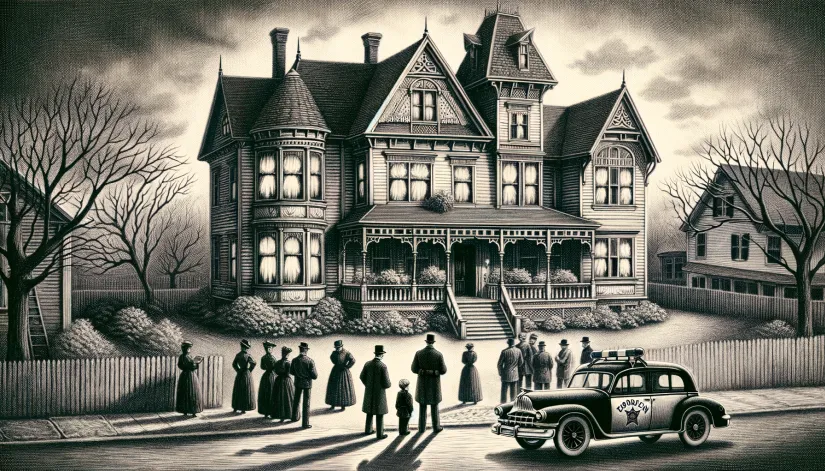The Lizzie Borden ax murders remain one of America’s most long-lasting mysteries.
Here’s the short story: In 1892, Lizzie Borden was accused of brutally killing her father and stepmother with an axe. Lizzie Borden’s trial was short… but sensational. And she was acquitted. Yet, decades after the events, many questions still remain.
Let’s start with the beginning:
In this article:
An Introduction to the Lizzie Borden Case
The Lizzie Borden case is still controversial, to say the least. Even so, many believe there is more than meets the eye. So, let’s take a closer look at the investigation, trial details, and modern analysis of this (unsolved) crime.
The Infamous Axe Murders of 1892
On August 4, 1892, the quiet town of Fall River, Massachusetts, was thrust into the national spotlight. The reason?
The Borden household, a well-known and respected family in the community, became the center of an appalling tragedy.
Andrew Jackson Borden and his wife, Abby Borden, were found brutally murdered in their home (a Victorian home located at 92 Second Street), setting off a chain of events that would captivate and horrify the entire nation.
Andrew—a prosperous businessman—and Abby—his second wife—were respected members of their community, making the brutality of their deaths even more shocking. Especially given how brutal the murder was.
“A horrifying tableau of violence and bloodshed,” according to police reports.
Initial Crime Scene Analysis
Here’s what we know for sure: Andrew Borden’s body was discovered in the downstairs sitting room, slumped on a sofa. His face, skull, and body were bearing the brutal marks of an assailant’s rage.
On the other hand, Abby Borden’s lifeless body was found in an upstairs bedroom. Her body was in a similar state.
The precision and ferocity of the strikes suggested a personal vendetta (with the murder weapon leaving clean yet devastating cuts, indicative of a sharp and heavy instrument).
One key role in the initial police assessments and crime scene analysis was played by Bridget Sullivan (the family’s housemaid).
She claimed she was in the house on the day of the murders. In fact, her account of the events leading up to the discovery of the bodies provided some valuable insights. However, the police did not see her as a suspect.
Another aspect worth mentioning here is that, while the local police were quickly on the scene, the investigation was somehow hampered by the rudimentary forensic techniques (of the time). Plus, the initial confusion and shock among the household members and neighbors didn’t help either.
One thing is for sure: the detectives assigned to investigate were unfamiliar with crimes of such brutality. And, as common in such situations, that may have messed up the gathering and analysis of physical evidence.
The fact that the whole crime scene was a horror show with potentially crucial pieces of evidence spread all over the place and improperly trained police officers stomping everywhere—none of these made things any easier.
Did you know?
Despite the gruesome nature of the murders, there was surprisingly little blood on Lizzie Borden when the police arrived. Many speculated how she could have avoided getting blood on herself if she were the killer, leading to theories that she may have committed the murders while wearing a coverall or immediately changed clothes afterward.
However, after a number of inconsistencies in her story and after changing her testimony a couple, the murdered couple’s daughter—Lizzie Borden—was arrested.
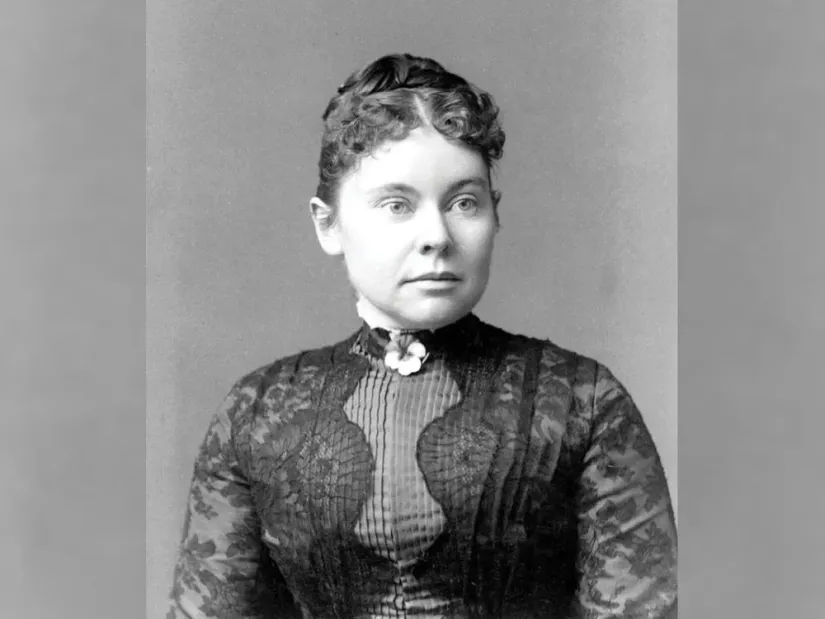
Lizzie Borden: A Profile
Lizzie Borden, at 32, was still an unmarried woman, which cast her as a spinster in the eyes of her 19th-century Fall River, Massachusetts, community.
Despite her family’s wealth and standing, her single status influenced her social position and interactions.
As an interesting fact about Lizzie Borden, her relationship with her father (Andrew) and her stepmother (Abby) was notably strained. This tension (underscored by financial disagreements and familial discord) was well-known in their circle.
Before the murders, Lizzie’s public perception was largely shaped by her family’s status and her role within it. As a member of a respected household, she was part of the local social fabric (albeit marked by her spinsterhood and the whispered-about family tensions).
However, following the brutal murder of her parents, public opinion shifted dramatically.
The community and the nation watched as she transformed from a quiet member of a wealthy family into the center of a sensational murder case.
Scrutiny intensified around her unusual post-murder calmness and known discontent with her family situation.
The dramatic shift in how Lizzie was viewed—from a respectable, if somewhat pitiable, figure to a suspect in a gruesome crime—reflected the sensationalist fervor of the time and the complexities of her social standing and family dynamics.
The Investigation
Autopsy and Murder Weapon
Dr. D. W. Millard conducted the autopsies on Andrew and Abby Borden, revealing the gruesome extent of their injuries.
According to the coroner’s report, Andrew Borden suffered multiple blows to the head, one of which was so severe it split his eyeball, indicating the attack was both vicious and personal.
Abby Borden’s injuries were similarly brutal, with strikes to the back of her head that suggested she was attacked from behind.
The nature and severity of these wounds led Dr. Millard to speculate that a hatchet or an axe could be the murder weapon.
This hypothesis was based on the “clean yet deep lacerations” present on both victims. In short, the cuts were consistent with such tools’ sharp edges and weight.

The cuts Dr. Millard observed during the autopsy proved to be consistent with a hatchet’s blade the police found in the Borden household. Finding the murder weapon was a massive breakthrough in the investigation.
However, conclusively linking it to the actual murders was complicated by the lack of forensic methods to analyze bloodstains or fingerprints conclusively.
So, Dr. Millard’s conclusions about the murder weapon were based solely on his personal comparison with the injuries and not on any scientific analysis.
Lizzie Borden’s Weak Alibi
What was Lizzie Borden’s alibi? Well, she claimed she was in the barn loft when her parents were murdered. As you can expect, the police considered her alibi weak and questionable—to say the least.
She offered inconsistent stories about her whereabouts and activities on the day of the murders, leading to doubts about the credibility of her testimony.
She mentioned being in the barn loft eating pears and looking out the window most of the time, claiming she saw no intruder or escaping assassin.
Yet, this aspect was not brought up during the trial. Despite Lizzie’s unsuccessful attempts to establish a solid alibi and the prosecutor’s suspicion of her changing stories.
Interesting fact:
During the investigation, Lizzie Borden was caught attempting to purchase prussic acid (a deadly poison) from a local drugstore just days before the murders. She claimed it was to clean a seal skin cloak, but the pharmacist refused the sale.
Lizzie Borden’s Trial
Lizzie Borden’s trial took place in New Bedford, Massachusetts, from June 5 to June 20, 1893.
Key Witnesses and Testimonies
The trial of Lizzie Borden brought forward several key witnesses whose testimonies were pivotal in shaping the case’s narrative.
Bridget Sullivan, the Bordens’ Irish maid, provided crucial testimony regarding the events of the day of the murders, including Lizzie’s whereabouts and behavior.
The maid’s account placed Lizzie in the home at the time of Andrew Borden’s murder, raising even more questions about Lizzie’s potential involvement.
Emma Borden, Lizzie’s older sister, also testified, offering a character witness for Lizzie and trying to establish an alibi for the time of Abby Borden’s murder.
And she was successful—or at least partially successful. Ultimately, Emma’s staunch defense of her sister played a significant role in shaping public perception. It also contributed to the narrative of Lizzie’s innocence.
Spencer Borden and other acquaintances gave testimonies that further complicated the picture, with their accounts focusing on the Borden family dynamics, Lizzie’s behavior before and after the murders, and the overall atmosphere within the household.
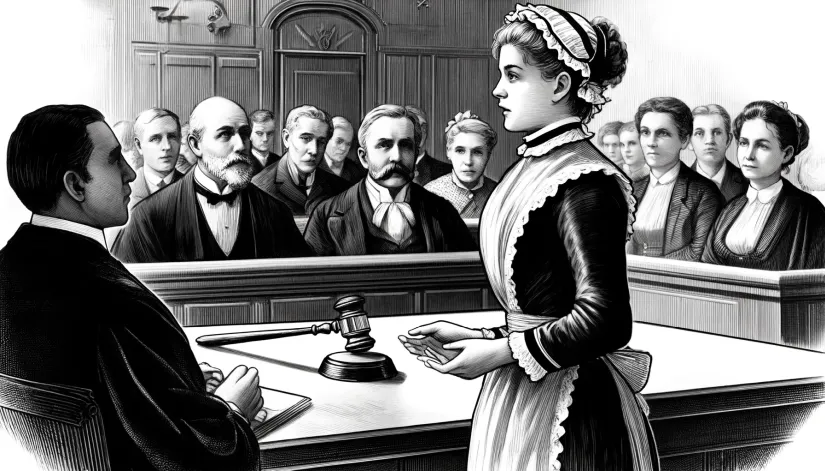
These testimonies were crucial in the trial, influencing both the jury’s perception and the broader public narrative.
However, it’s also worth noting that some witnesses may have been biased for or against Lizzie Borden.
The Prosecution’s Case Against Lizzie
Hosea Morrill Knowlton and William Henry. Moody was on the prosecution’s side.
Knowlton was the district attorney for the Southern District of Massachusetts at the time of the trial and the lead prosecutor in the case. He was a respected lawyer with a reputation for thoroughness and meticulousness.
On the other hand, Moody was the assistant prosecutor. He later had a distinguished career, serving as U.S. Attorney General, Secretary of the Navy, and eventually as an Associate Justice of the U.S. Supreme Court. His involvement in the Borden trial was one of the notable early highlights of his legal career.
The prosecution built its case against Lizzie Borden largely on circumstantial evidence, focusing on her behavior before and after the murders and the conspicuous lack of physical evidence directly linking her to the crime.
Knowlton and his team highlighted Lizzie’s inconsistent statements and peculiar demeanor as indicative of guilt.
Her alibi (considered weak and unreliable) was scrutinized, with prosecutors arguing that her presence at the house during the time frame of the murders, coupled with her subsequent actions, pointed to her involvement.
However, as mentioned before, the lack of direct evidence was a significant challenge for the prosecution. Without the ability to gather and analyze DNA and fingerprints, the prosecution was forced to establish guilt through other means.
For 19th-century forensics, this typically meant focusing on other physical evidence (such as bloody clothing, bloodstains, and the murder weapon) as well as document examination and crime scene photography. None of these conclusively linked Lizzie to the murders.
Even the hatchet found in the Borden home (believed to be the murder weapon) lacked forensic confirmation. Basically, the hatched could have been the murder weapon, but it was almost impossible to say for sure.
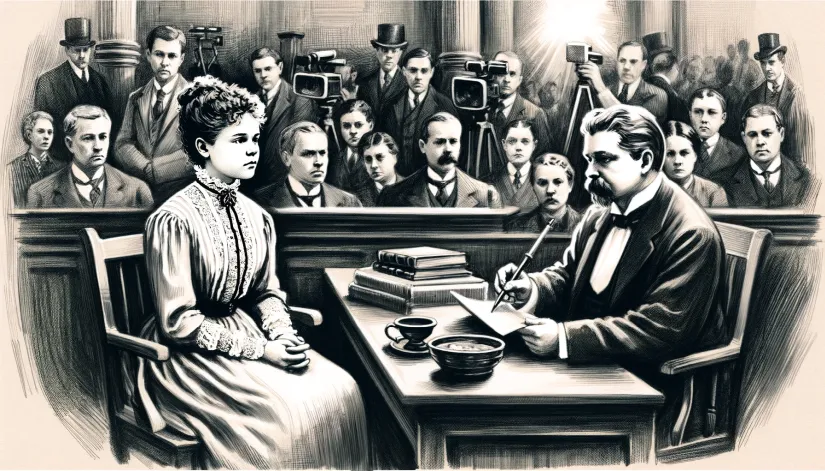
The Defense Strategy
Lizzie’s defense was led by former Massachusetts Governor George D. Robinson. He worked with two talented lawyers: Andrew V. Jennings (who was the Borden family’s personal attorney and had represented the family in legal matters prior to the trial) and Melvin O. Adams.
They had a much easier job. All they had to do was prove that the prosecution relied on circumstantial evidence.
So, Robinson and his team’s strategy was pretty simple: just expose the lack of direct evidence linking Lizzie to the gruesome axe murders.
And that’s what they did. The defense meticulously questioned the integrity of EVERY SINGLE piece of evidence the police obtained during the investigation.
A pivotal moment in the trial was when the defense called a bunch of witnesses to testify about Lizzie’s character and her alibi.
Prominent among these were family friends (as mentioned above), members of the local church, and those acquainted with Lizzie’s charitable work. Every single witness portrayed Lizzie as a woman of high moral standing and unlikely to commit such brutal acts.
Additionally, the defense challenged the timeline of events as presented by the prosecution, suggesting that Lizzie’s presence in the barn loft at the time of her father’s murder provided her with a credible alibi.
The defense also scrutinized one of the few physical pieces of evidence the police were able to collect: a burned dress.
Lizzie’s friend, Alice Russell, testified about seeing Lizzie burn a dress days after the murders, which the prosecution suggested was stained with blood.
However, Jennings convinced the jury that there was no definitive proof that the dress was even relevant to the case (or that it bore any connection to the day of the murders).
Verdict and Public Reaction
On June 20, 1893, after deliberating for just 90 minutes, the jury returned a verdict of not guilty, acquitting Lizzie Borden of the charges of murdering her father and stepmother.
As expected in such a case, the immediate public reaction to the verdict was polarized. This is not surprising in 19th-century society, which was so divided over issues of social class, gender roles, and the influence of the media.
Lizzie’s social standing as a prominent member of the Fall River family, combined with prevailing gender norms that perceived women as incapable of such brutal acts, played noteworthy roles in shaping public opinion and, possibly, the jury’s decision.
Did you know?
Following her acquittal, Lizzie Borden and her sister Emma moved into a large, modern house in Fall River, which Lizzie named “Maplecroft.” Despite her acquittal, Lizzie faced lifelong ostracism from the community. She lived out her remaining years relatively isolated, shunned by many who believed she had gotten away with murder.
On the other hand, just as many were shocked and outraged by the acquittal. In their mind, Lizzie was guilty. Circumstantial evidence or not, the sensationalized media coverage during the trial was more than enough to convince them ‘of the truth.’
Responsible for the divided public response were (at least partially) the many newspapers across the country that did nothing else but fuel a media frenzy, painting Lizzie as both a cold-blooded murderer and a victim of circumstance.
Legal Definitions and their Role in the Trial
Now, it’s time to shed some light on something most articles about Lizzie Borden’s case get wrong: the legal definitions. Why do they matter so much?
It matters because understanding legal terms such as manslaughter, premeditated murder, and circumstantial evidence is necessary for grasping the intricacies of Lizzie Borden’s trial.
Premeditated murder refers to a killing that was planned or thought out ahead of time, indicating intent. On the other hand, manslaughter involves a killing that occurs without premeditation, often in the heat of the moment.
Circumstantial evidence consists of information and testimony that indirectly imply a conclusion, as opposed to direct evidence like eyewitness accounts.
The prosecution sought to prove that Lizzie Borden committed premeditated murder. But that’s where they may have made a crucial mistake.
Their case was not solid enough (with a heavy reliance on circumstantial evidence due to a lack of direct eyewitnesses or conclusive physical evidence) to prove, without a doubt, that Lizzie had planned the murders.
It’s also likely why the defense strategy was so effective at countering the prosecution’s case.
All the defense had to do was highlight the absence of concrete evidence linking Lizzie to the murders, question the reliability of circumstantial evidence, and emphasize the lack of motive.

Was Lizzie Borden Guilty?
Many have asked this question over the past decades. And many theories and alternative perspectives are still trying to shed some light on this unusual murder case.
Here’s our take on all this:
The Inheritance and Financial Motives
One of the most common theories surrounding the Lizzie Borden murders centers on inheritance and financial motives.
This theory hinges on the idea that Lizzie stood to gain a significant sum of money from the deaths of her father, Andrew Borden, and stepmother, Abby Borden.
Here’s the interesting aspect of that theory. Yes, the Borden family was undeniably wealthy. Andrew Borden had amassed a considerable fortune through various investments, particularly in real estate. Plus, the distribution of this wealth was a known source of tension within the family.
Lizzie and her sister Emma believed they were not receiving their fair share. This discontent was fueled by Andrew’s second marriage to Abby (whom some speculate Lizzie resented).
Psychological Theories and Fugue State
Beyond the gruesome details, a bunch of psychological theories have also tried to explain Lizzie’s state of mind at the moment of the murders.
One fascinating proposition centers on a fugue state, a dissociative episode where a person commits acts with no memory afterward.
However, the fugue state theory isn’t universally accepted. Renowned criminal profiler John Douglas, author of “The Cases That Haunt Us,” dismissed it as speculative. Douglas argued that fugue states are typically brief and rarely involve violent acts.
In fact, psychological analysis paints a much more complex picture. We believe that Lizzie’s life under a domineering father and a strained relationship with her stepmother could have contributed to an extreme psychological break.
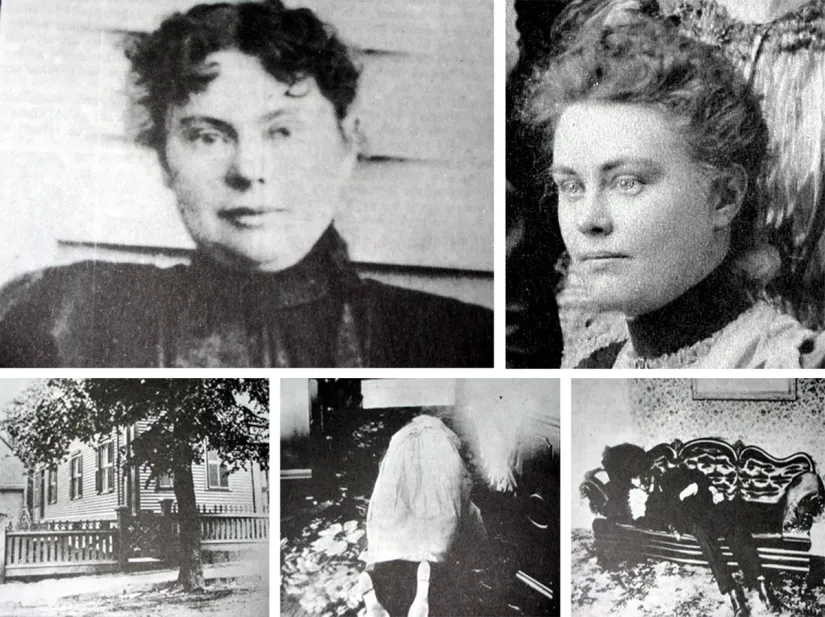
Modern Forensic Analysis and Re-examination of the Case
The limitations of forensic science at the time left many questions unanswered.
Thankfully, modern techniques have allowed experts to re-examine the evidence, offering new avenues for exploration.
Bloodstain Analysis Under the Microscope
Bloodstain pattern analysis (BPA) has been used to investigate the Lizzie Borden case. What’s the process? Well, BPA involves interpreting bloodstains at a crime scene to understand the actions that caused the bloodshed.
Analysts can examine various aspects of bloodstains (such as size, shape, distribution, and location) to form opinions about what may have occurred. This analysis helps in recreating the sequence of events after the bloodshed and can provide crucial insights into the dynamics of a crime scene.
However, there’s an issue. There are some significant concerns and criticisms regarding bloodstain pattern analysis in forensic investigations:
1) A national study criticized BPA
A national study criticized various forensic sciences, including blood spatter analysis, for lacking scientific grounding and reliability.
The 2009 National Academy of Sciences report emphasized the subjectivity of bloodstain pattern analysis. It stated that opinions in this field are more subjective than scientific and highlighted the significant uncertainties associated with BPA.
2) Case examples
The story of Julie Rea highlights the potential pitfalls of bloodstain-pattern analysis (BPA) in the justice system.
Convicted of killing her son based on BPA testimony, Julie was later acquitted and exonerated, exposing the flaws and risks associated with this type of forensic evidence.
Similarly, Brad Jennings’ case underscores the impact of faulty forensic analysis. He was released after new evidence confirmed his claim that his wife had committed suicide, not been murdered.
Both cases illustrate how unreliable BPA can lead to wrongful convictions, affecting innocent lives and undermining trust in the legal process.
3) Error rates and scrutiny
Recent studies have reported error rates in bloodstain pattern analysis, indicating that analysts’ conclusions can be wrong a significant percentage of the time. This raises concerns about the reliability of BPA in forensic investigations.
Frequently Asked Questions
Was Lizzie Borden Guilty of the murders?
Lizzie Borden was tried and acquitted of the August 4, 1892, axe murders of her father and stepmother. Despite being acquitted, she remained the prime suspect in the murders.
Various theories have been proposed, including the possibility that she committed the murders while in a fugue state or due to alleged physical and sexual abuse by her father.
What was the motive for the Lizzie Borden murders?
The motive for the Lizzie Borden murders remains a subject of speculation. Conflicts within the family, disagreements over property division, and a strained relationship between Lizzie and her stepmother are cited as potential motives.
On top of that, there were claims of abuse by her father and disagreements over his actions, such as killing her pigeons.
What is the rhyme about Lizzie Borden?
A popular yet inaccurate rhyme about Lizzie Borden goes:
“Lizzie Borden took an ax
And gave her mother forty whacks,
And when she saw what she had done,
She gave her father forty-one.”
Was there ever any physical evidence against Lizzie Borden?
During the trial, the skulls of the victims were presented as evidence along with circumstantial evidence, like a hatchet head found in the basement. However, much of the prosecution’s case was composed of circumstantial evidence, leading to Lizzie’s acquittal due to a lack of concrete proof.
Who else was in the house at the time of the murders?
At the time of the murders, besides Lizzie Borden herself, her father, Andrew J. Borden, and stepmother, Abby Borden, were present in the house. The maid Bridget Sullivan also played a role in discovering the bodies and was part of the events surrounding the murders.
What was the murder weapon in the Lizzie Borden case?
The murder weapon in the Lizzie Borden case was a hatchet found in the Borden home. However, it lacked forensic confirmation as the instrument used in the killings.
What was the motive for the Lizzie Borden murders?
The motive for the murders is not definitively known, but several theories have been proposed. Some speculate that Lizzie may have been driven by resentment towards her stepmother, Abby Borden, due to strained relations between them.
Others suggest that Lizzie may have been motivated by a desire to inherit her father’s wealth or anger over the property transfer to Abby’s sister.
Additionally, there were reported tensions within the family, with Lizzie and her sister Emma leaving Fall River by coach for New Bedford following a family argument. However, none of these theories can be proven conclusively.
Is Lizzie Borden’s case considered solved?
Lizzie Borden’s case remains unsolved despite her acquittal. While acquitted at trial, she remained the prime suspect in the murders of her father and stepmother. Various theories exist about the murders, but no definitive conclusion has been reached.
What theories exist about the murders?
Many theories exist about the murders of Andrew and Abby Borden. These theories range from Lizzie committing the murders in a fugue state to allegations of physical and sexual abuse by her father, driving her to kill him.
Other theories suggest a possible lesbian relationship between Lizzie and the family maid, Bridget Sullivan. The most common explanation revolves around potential instability in Lizzie’s mental state at the time of the murders.

